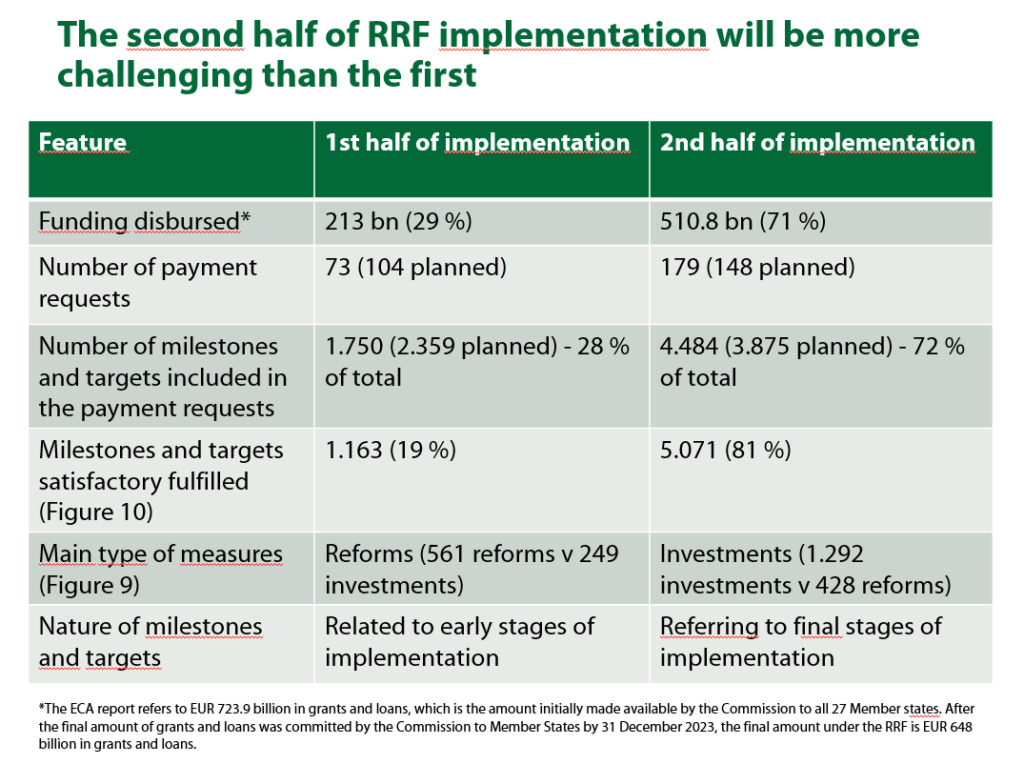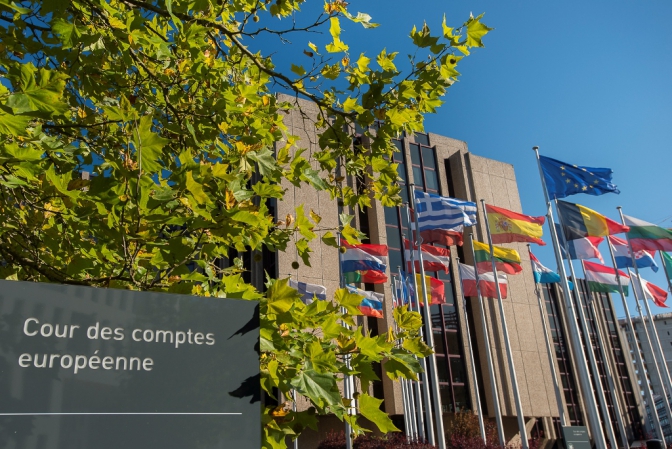The first three years of the EU’s Recovery and Resilience Facility (RRF) have seen delays in funds being disbursed and projects being implemented, according to a new audit report published by the European Court of Auditors (ECA) last week.
Established in February 2021, the RRF finances reforms and investments in EU countries, starting with the onset of the pandemic in February 2020 and ending in August 2026. It focuses on six priority areas, including the green transition and digital transformation. Countries receive the money based on the progress made in milestones and targets and not on actual costs incurred, as in other EU funding.
As in an opinion in September 2020, the auditors stress that the RRF rules make no provision for recovering funds when milestones and targets are fulfilled, but measures are ultimately not completed. In fact, this is the third audit report where ECA delivers severe critique of the RRF and what it considers to be design flaws jeopardizing sound financial management of EU funds.
In March 2023, ECA found that the RRF does not assure that the money spent by the Member States complies with EU and national rules. “Currently, there is a gap in terms of the assurance the Commission can provide for the EU’s main pandemic recovery fund and a lack of accountability at the EU level,” said ECA President Tony Murphy.
In designing the RRF in an emergency situation, the EU prioritized speed and effectiveness and did not address the issue of backsliding in the milestones and targets.
The other audit report, in October 2023, identified weaknesses in the monitoring system that make it insufficient for measuring overall performance. “We are in a paradoxical situation where for the EU’s largest fund that is claimed to be performance-based, we can measure progress but not performance itself,” said Ivana Maletić, the ECA member in charge of the report.
From disbursement to implementation
According to the new audit report, by the end of 2023 only €213 billion or 30 % of the total funds had been transferred from the Commission to the Member States. This does not mean that they necessarily had reached final recipients on the ground. In fact, almost half of the RRF funds disbursed to the 15 Member States that provided the necessary information had not yet reached operators in the real economy.
Even though the rate of payments from the European Commission is progressing, auditors warn that Member States might not be able to draw down or absorb the funds in time and complete their planned measures before the RRF expires in August 2026. The only positive is that pre-financing of up to 13 % of the total amount allowed funds to be paid out quickly at the start.
“Timely absorption of the RRF is essential. It helps avoid bottlenecks in carrying out the measures towards the end of the Facility’s lifespan, and reduces the risk of inefficient and erroneous spending,” said the Ivana Maletić, the ECA Member in charge of the audit and a former MEP and senior official in the ministry of finance in Croatia.
“We are flagging risks, as EU countries had drawn down less than a third of the planned funds at the halfway point and made less than 30 % progress towards reaching their pre-defined milestones and targets,” she said at virtual press conference presenting the audit report (2 September).
Almost all countries experienced delays in submitting payment requests to the Commission, often because of inflation or supply shortages, uncertainty about environmental rules, and insufficient administrative capacity.
For different reasons, seven countries had not received any funds for the satisfactory fulfilment of milestones and targets. Less than 30 % of the more than 6,000 milestones and targets (i.e. indicators of progress) were presented for payment, meaning that a significant number – possibly those that are most difficult – are yet to be fulfilled.

Credit: ECA audit report
Glass half empty or full
In its response, the Commission welcomed the audit report and claimed that the picture is overall positive. It disagrees with ECA that disbursement and absorption of the fund has been slow. The fund has picked up speed since the end of 2023, the cut-off date of the audit. The estimated rate of fulfilment of milestones and targets is currently (1 September) at around 40 % and will increase to 59 % by end 2024.
The audit team is less optimistic about the implementation of the RRF. “In general projects started with signing contracts but now they have to progress and fulfil more difficult milestones and targets related to the finalisation of the outputs and results coming out of the reforms. It becomes more difficult to fulfil the more complex milestones and targets defined for the later stages.”
Some countries have submitted few payment requests or none at all (Hungary and Sweden). “They risk not to fulfil RRF’s objective to address the consequences of the COVID-crisis,” the audit team told The Brussels Times. “They also run the risk of having to implement a large number of measures at the end of the RRF which increases the risk of inefficient and erroneous spending.”
Can funding be recovered?
A bone of contention is whether funding to non-completed projects can be recovered by the Commission. ECA highlights this as a risk because 5 % of the measures lack milestones or targets indicating the completion of that measure. Furthermore, without amending the RRF regulation the Commission lacks a tool to recover funding allocated to non-completed projects.
The Commission admits that it is possible that a limited number of projects will not be completed in time but adds that this would result in partial payment. The regulation states that recovery should be possible if the RRF plan has not been implemented in a "satisfactory manner" or in the case of serious irregularities (fraud, corruption and conflicts of interest).
However, by satisfactory implementation is meant progress in implementation which the Commission describes as “part of the core of DNA of the RRF”. Most of the milestones and targets are output-oriented, according to ECA, and not results-impacts oriented linked to the RRF objectives.
The Commission does not define non-completion of a project as a risk considering the design of the legal system. But it says that it can reduce a Member States’ funding afterwards, in case it reverses a previously fulfilled milestone or target. In its reply to the audit, the Commission did not accept ECA’s recommendation to mitigate the risk of funding non-completed measures.
As in previous audits, ECA did not consider amendments to the RRF regulation halfway in its implementation and recommended addressing design flaws when setting up future spending programmes. “We are not policymakers. It is up to the Commission to decide the best option to solve the weaknesses,” the audit team says.
M. Apelblat
The Brussels Times

